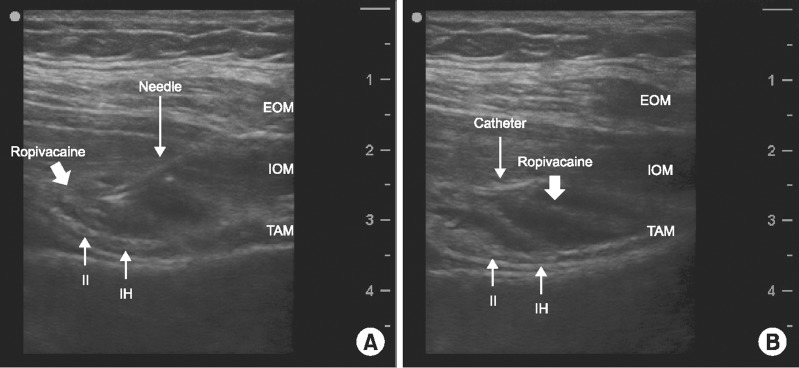Korean J Pain.
2016 Jul;29(3):193-196. 10.3344/kjp.2016.29.3.193.
Continuous Ilioinguinal-iliohypogastric Nerve Block for Groin Pain in a Breast-feeding Patient after Cesarean Delivery
- Affiliations
-
- 1Department of Anesthesia and Pain Medicine, School of Medicine, Pusan National University, Busan, Korea. hakykim@pusan.ac.kr
- KMID: 2327642
- DOI: http://doi.org/10.3344/kjp.2016.29.3.193
Abstract
- Ilioinguinal and iliohypogastric (II/IH) nerve injury is one of the most common nerve injuries following pelvic surgery, especially with the Pfannenstiel incision. We present a case of intractable groin pain, successfully treated with a continuous II/IH nerve block. A 33-year-old woman, following emergency cesarean section due to cephalopelvic disproportion, presented numbness in left inguinal area and severe pain on the labia on the second postoperative day. The pain was burning, lancinating, and exacerbated by standing or movement. However, she didn't want to take additional medicine because of breast-feeding. A diagnostic II/IH nerve block produced a substantial decrease in pain. She underwent a continuous II/IH nerve block with a complete resolution of pain within 3 days. A continuous II/IH nerve block might be a goodoption for II/IH neuropathy with intractable groin pain in breast-feeding mothers without adverse drug reactions in their infants.
Keyword
MeSH Terms
Figure
Reference
-
1. Rahn DD, Phelan JN, Roshanravan SM, White AB, Corton MM. Anterior abdominal wall nerve and vessel anatomy: clinical implications for gynecologic surgery. Am J Obstet Gynecol. 2010; 202:234.e1–234.e5. PMID: 20022582.
Article2. Cardosi RJ, Cox CS, Hoffman MS. Postoperative neuropathies after major pelvic surgery. Obstet Gynecol. 2002; 100:240–244. PMID: 12151144.
Article3. Luijendijk RW, Jeekel J, Storm RK, Schutte PJ, Hop WC, Drogendijk AC, et al. The low transverse Pfannenstiel incision and the prevalence of incisional hernia and nerve entrapment. Ann Surg. 1997; 225:365–369. PMID: 9114794.
Article4. Loos MJ, Scheltinga MR, Mulders LG, Roumen RM. The Pfannenstiel incision as a source of chronic pain. Obstet Gynecol. 2008; 111:839–846. PMID: 18378742.
Article5. Hahn L. Treatment of ilioinguinal nerve entrapment - a randomized controlled trial. Acta Obstet Gynecol Scand. 2011; 90:955–960. PMID: 21615360.
Article6. Benito-Léon J, Picardo A, Garrido A, Cuberes R. Gabapentin therapy for genitofemoral and ilioinguinal neuralgia. J Neurol. 2001; 248:907–908. PMID: 11697532.
Article7. Garvey JF. Computed tomography scan diagnosis of occult groin hernia. Hernia. 2012; 16:307–314. PMID: 22167621.
Article8. Leem JG. Ultrasound-guided nerve blocks for post-hernia repair pain. Korean J Pain. 2010; 23:227–229. PMID: 21217884.
Article9. Palumbo P, Minicucci A, Nasti AG, Simonelli I, Vietri F, Angelici AM. Treatment for persistent chronic neuralgia after inguinal hernioplasty. Hernia. 2007; 11:527–531. PMID: 17668147.
Article10. Gucev G, Yasui GM, Chang TY, Lee J. Bilateral ultrasound-guided continuous ilioinguinal-iliohypogastric block for pain relief after cesarean delivery. Anesth Analg. 2008; 106:1220–1222. PMID: 18349197.
Article11. Soussan C, Gouraud A, Portolan G, Jean-Pastor MJ, Pecriaux C, Montastruc JL, et al. Drug-induced adverse reactions via breastfeeding: a descriptive study in the French Pharmacovigilance Database. Eur J Clin Pharmacol. 2014; 70:1361–1366. PMID: 25183382.
Article12. Davanzo R, Dal Bo S, Bua J, Copertino M, Zanelli E, Matarazzo L. Antiepileptic drugs and breastfeeding. Ital J Pediatr. 2013; 39:50. PMID: 23985170.
Article13. Lanza di Scalea T, Wisner KL. Antidepressant medication use during breastfeeding. Clin Obstet Gynecol. 2009; 52:483–497. PMID: 19661763.
Article
- Full Text Links
- Actions
-
Cited
- CITED
-
- Close
- Share
- Similar articles
-
- Ilioinguinal and Iliohypogastric Nerve Block for Neuropathic Pain Following the Laparoscopic Surgery
- Diagnosis of Ilioinguinal Nerve Injury Based on Electromyography and Ultrasonography: A Case Report
- Combined epidural anesthesia and ultrasound guided peripheral nerve block for wound revision in a patient with peripartum cardiomyopathy: A case report
- A Comparison between Ilioinguinal and Iliohypogastric Nerve Block and Infiltration of Local Anesthetics for Postoperative Pain after Inguinal Herniorrhaphy in Children
- Percutaneous ilioinguinal-iliohypogastric nerve block or step-by-step local infiltration anesthesia for inguinal hernia repair: what cadaveric dissection says?


